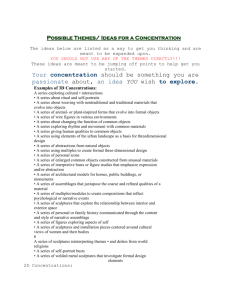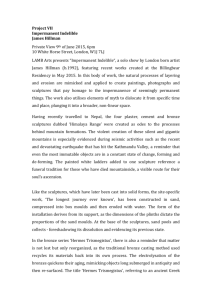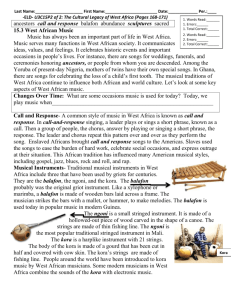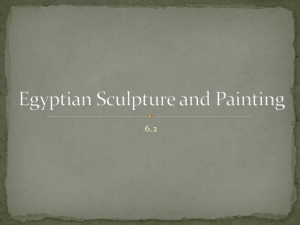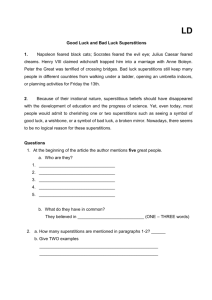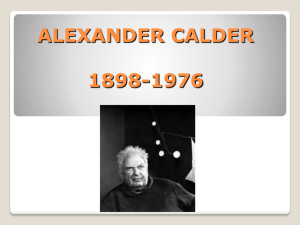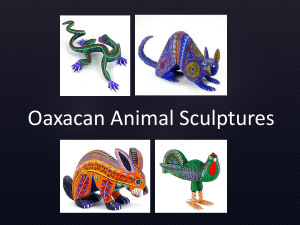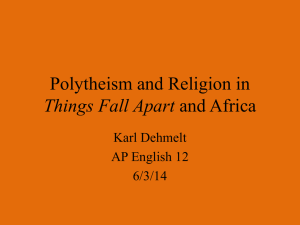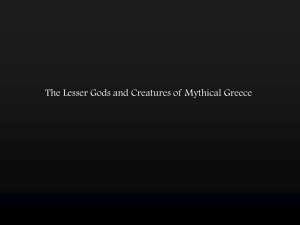African Art After the 1800s
advertisement
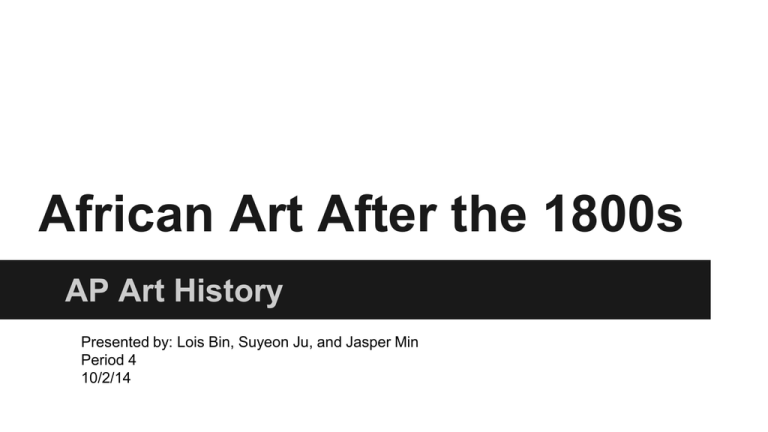
African Art After the 1800s AP Art History Presented by: Lois Bin, Suyeon Ju, and Jasper Min Period 4 10/2/14 African Art in a Nutshell Rock paintings and ancestor veneration The San tribe’s rock paintings of the 1800s served a common theme of representing humans and animals. In their era of agriculture and domesticated animals, these paintings depicted scenes of livestock raids and hunted or spiritual animals. In one example, humans are seen leading animals, a ritual for rainmaking as a way of subverting the government. Along with spiritual forms of art, many late-African arts practiced ancestral worship. Sculptures were ornate with luxurious clothing or weapons and symbolism for power such as double-headed snakes, elephant tusks, or warriors. Embellished stools or chairs served to elevate the ancestor or leader, and the use of a hierarchy of scale mitigated the size of females, servants, or surrounding people to venerate the ancestor. The Benin shrine was sculpted in honor of royal ancestors. It was thought to repel evil and was a symbol for wisdom and divine guidance. Spiritual sculptures The style and function of art differed from region to region, in late Africa. Kongos sculpted for royal décor or medicinal purposes, as well as for crop growth, weakening an enemy, or social regulation. These sculptures were made more realistic and organic with enlarged heads. The Dogons are known for their sculptures of human couples. They depicted the gender roles of the time; the men were hunters or warriors, while women were mothers. Their purpose and identity is uncertain, but they are thought to have been deities and placed in shrines. These sculptures were geometric and more conceptual rather than encompassing optical realism. The Baules of late Africa often sculpted bush spirits, a medium for connecting to spirits by a trance diviner. Bush spirits were housed in the diviner’s home. They were naturalistic but exaggerated in length and proportion. Both the Dogon and Baule’s sculptures were known for their use of wood. In Ise, Nigeria lived one of the most seminal carvers of late Africa. Olowe worked for patrons such as commoners or often the king. He would sculpt tall, stacked, and elongated figures and with great detail in texture. Olowe was known for the complexity of his sculptures and his use of open space. African Art in a Nutshell continued... Masquerades and costumes Masquerades were a cultural paradigm of Africa at the time. They were performed for the purpose of socialization, initiation, transformation from life to death, and connection to spirits. The performers were usually male and would represent ancestors, spirits, humans, and animals. Though performers were often male, the representation of women and female ancestors were common. The masks were wood and lavished with feathers, beads, and animal skin. In special occasions, costumes and body paint were also a custom. Costumes would be comprised of elaborate hair and jewelry and would be worn by all ages. The grandiose and type of costume worn signified age, marital or initiation status, or a warrior. Igbo A singular Igbo tradition was their construction of houses for deities. These mbari houses were built from mud and housed over a hundred clay sculptures and paintings. Sculptures of the deity, like Ala the goddess of the earth, had elongated heads, necks, and torsos to exude power. The final unveiling of the house to the public denotes the deity’s acceptance of the house. Mbari houses were never torn down and stood until they naturally wore away. Contemporary More recent art forms of Africa connect traditionalism and modernism. Painted posts depict ancestral renderings and narratives, while other paintings convey social and political issues of the time. Modern African art utilizes symbolism, bright colors, and writing, at times all composed in a collage. They serve more for tourists and galleries, in lieu of rituals and have become more secular from the influence of Western culture and various cultures. Q-Card 1:Nail Figure D: ca. 1875-1900 P/S: 19th century A: Unknown M/T: Wood, nails, blades, medicinal materials, and cowrie shell/ carving, inserting nails into statue F: Believed to embody spirits for healing and harming of the body C: Deep part of priestly religious duties DT: 3’10 ¾” high, Protruding abdomen made from cowrie shell, Impaled with nails, simple anatomical forms, very large head. Ideas: Power figure- houses spiritual and divine beings Q-Card 2: Seated Couple D: ca. 1800-1850 P/S: 19th century A: Unknown M/T: Wood/carving F: Bush spirits for trance diviners, communication with spirits C: African gender roles & spiritual piety DT: Man is equipped with a quiver, woman with a child. Exaggerated neck, head, & calf muscles Ideas: Naturalistic, ideal human, depicts importance of each gender in society Q-Card 3: Senufo Masquerader D: ca. 1980-1990 P/S: 20th century A: Unknown M/T: Wood, leaves, fabric, bones (teeth, etc.), pigment from earth/carving, painting F: Characterize a spirit (human, animal, otherworldly being) C: Power sources of oracles DT: Used in initiation, life to death transformation, entertainment Ideas: Embodies ancestors or various nature spirits Comparative Analysis Images Figure 34-9 Figure 5-8 Seated Couple, ca 1800-1850 Kouros, ca. 600 BCE Comparative Analysis Similarities: ● Portray nudity ● Frontal body position ● Full-rounded Differences: Seated Couple: ● Less rigid (bent arms and legs, seated) ● Show role of each gender in society -man hunts (quiver on back) -woman nurtures children (child on back) ● Displays casual affection ● Wood ● Spiritual purposes Kouros: ● Stiff and rigid stance ● Used to show beauty and perfection of young men’s bodies ● Almost no expression (other than slight Archaic smile) ● Marble ● Funerary purposes
